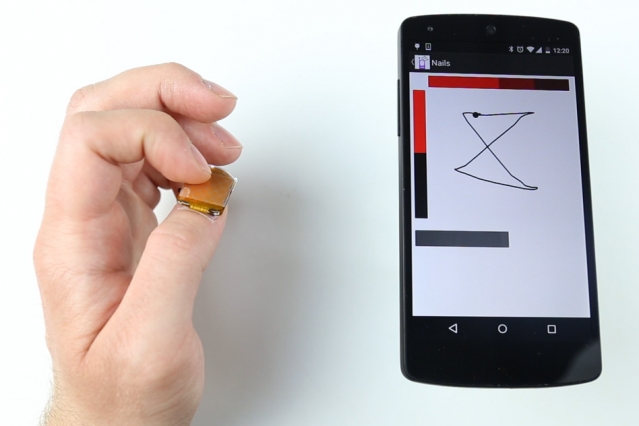Next week at the Association for Computing Machinery’s Computer-Human Interaction conference in Seoul, MIT researchers will describe the prototype of NailO.
The researchers envision that a commercial version of their device would have a detachable membrane on its surface, so that users could coordinate surface patterns with their outfits. To that end, they used capacitive sensing — the same kind of sensing the iPhone’s touch screen relies on — to register touch, since it can tolerate a thin, nonactive layer between the user’s finger and the underlying sensors. As the site for a wearable input device, however, the thumbnail has other advantages: It’s a hard surface with no nerve endings, so a device affixed to it wouldn’t impair movement or cause discomfort. And it’s easily accessed by the other fingers — even when the user is holding something in his or her hand.

A new wearable device, NailO, turns the user’s thumbnail into a miniature wireless track pad. Here, it works as a X-Y coordinate touch pad for a smartphone. Courtesy of MIT Media Lab
According to Cindy Hsin-Liu Kao, an MIT graduate student in media arts and sciences and one of the new paper’s lead authors, the device was inspired by the colorful stickers that some women apply to their nails. “It’s a cosmetic product, popular in Asian countries,” says Kao, who is Taiwanese. “When I came here, I was looking for them, but I couldn’t find them, so I’d have my family mail them to me.”
To build their prototype, the researchers needed to find a way to pack capacitive sensors, a battery, and three separate chips — a microcontroller, a Bluetooth radio chip, and a capacitive-sensing chip — into a space no larger than a thumbnail. “The hardest part was probably the antenna design,” says Artem Dementyev, a graduate student in media arts and sciences and the paper’s other lead author. “You have to put the antenna far enough away from the chips so that it doesn’t interfere with them.”
For their initial prototype, the researchers built their sensors by printing copper electrodes on sheets of flexible polyester, which allowed them to experiment with a range of different electrode layouts. But in ongoing experiments, they’re using off-the-shelf sheets of electrodes like those found in some track pads.
At small scales, energy efficiency is at a premium so the device would have to be deactivated when not actually in use. In the new paper, the researchers also report the results of a usability study that compared different techniques for turning it off and on. They found that requiring surface contact with the operator’s finger for just two or three seconds was enough to guard against inadvertent activation and deactivation.
“Is it the case that we’ll all be walking around with digital fingernails in five years’ time?” asks Steve Hodges, who leads the Sensors and Devices group at Microsoft Research in Cambridge, England. “Maybe it is. Most likely, we’ll have a little ecosystem of these input devices. Some will be audio based, which is completely hands free. But there are a lot of cases where that’s not going to be appropriate. NailO is interesting because it’s thinking about much more subtle interactions, where gestures or speech input are socially awkward.”






Comments